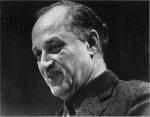
Avinu Malkeinu, (Hebrew: אָבִינוּ מַלְכֵּנוּ), translating to Our Father, Our King, is a prayer that is recited during Jewish services from Rosh Hashanah (Jewish New Year) to Yom Kippur (Day of Atonement) and on certain public fast days at other times of year. Each line of the prayer begins with the words Avinu Malkeinu, followed by varying phrases for the remainder of the verse. It often has a slow, chanting, repetitive aspect to the melody to represent the pious pleading within the prayer.
Now, many years later, I have “performed” this work in various contexts, occasionally as a concert piece, and more recently, in its place in the synagogue service, as it was intended. I know two versions of Avinu Malkeinu. A shorter traditional version is for congregational and public use and known by Jewish people around the globe.

Max Janowski
A more ambitious work is the version by Max Janowski (1912-1991). Berlin-born Janowski was a composer of Jewish liturgical music, a choir director, conductor and a voice teacher, who even taught piano in Japan before emigrating to the United States in 1937 where he served in the United States Navy during World War II. His singing students included the famous Baritone Sherrill Milnes. (New York Times)
Again, as with so much Jewish music, many arrangements of this work exists. Today even Rock and Club remixes – controversial as they are – can be found. While clearly written for cantor or soloist – in the original key would indicate a tenor or soprano – there are large choral sections, which are mainly repeats of the main part of the melody, especially recognisable on the opening phrase of Avinu Malkeinu. Marsha Edelman, writing on synagogue music in the modern era, alludes to a tension that developed between cantorial schools and congregants. In short, some cantorial schools (such as the Cantors Institute created in 1952) raised the art of the cantor to an enormously sophisticated level, but unfortunately left less opportunity for the congregation to sing as well. The time after World War II was one of tremendous adjustment and change for Jews throughout the diaspora. Composers such as Janowski and Max Wohlberg (1907-1996) included “singable refrains” into works that were written for cantor and/or chorus. Janowski’s Avinu Malkeinu does just that, allowing the congregants to join in the singing of parts of the prayer. While Orthodox Judaism prohibits accompaniment, Janowski’s is clearly for use with orchestral or organ accompaniment.
The many roles of the Hazzan (Cantor)
Over the centuries and across the diaspora, cantors took on a variety of religious and communal roles in addition to leading prayer services, including shohet (ritual slaughterer), mohel (performer of circumcisions), teacher and government official.

Avinu Malkeinu – Hewbrew Text and English Translation:
Avinu malkeinu sh’ma kolenu. Avinu malkeinu chatanu l’faneycha
Our Father our King, hear our voice. Father our King, we have sinned before Thee
Avinu malkeinu chamol aleynu, Ve’al olaleynu vetapeinu
Our Father our King, have compassion for us, and also on our children
Avinu malkeinu Kaleh dever, vecherev vera’av mealeynu
Our Father our King, bring and end to pestilence, war and famine around us
Avinu malkeinu kaleh chol tsar Umastin mealeynu
Our Father our King, bring an end to all trouble and oppression around us.
Avinu malkeinu, Avinu malkeinu, Kat’veinu besefer chayim tovim
Our Father our King, Our Father our King, inscribe us in the book of life
Avinu malkeinu chadesh aleynu, Chadesh aleynu shanah tovah
Our Father our King, renew upon us, renew upon us a good year
Sh’ma kolenu, Sh’ma kolenu , Sh’ma kolenu
Hear our voice, hear our voice, hear our voice
Avinu malkeinu, Avinu malkeinu, Chadesh aleynu shanah tovah
Our Father our King, Our Father our King, renew upon us a good year
Avinu malkeinu, Sh’ma kolenu, Sh’ma kolenu, Sh’ma kolenu
Our Father our King, hear our voice, hear our voice, hear our voice

Saving the Torah after Hurricane Katrina (New Orleans) 2005
A liturgical analysis of the Avinu Malkeinuby Michael Koplow can be found HERE.
For an arrangement of Janowski’s Avinu Malkeinu, in a lower key for vocal soloist, organ and small chamber ensemble, click HERE.
Sheet Music of very userfriendly arrangement of Janowski’s Avinu Malkeinu is available HERE.
Sheet music of the traditional version of Avinu Malkeinu can be found HERE.
Avinu Malkeinu (Janowski): Some recorded materials

A humble but sincere version combines Hebrew and Arabic, much to the consternation of some.
Nora Dori created this version in a stage performance. Even removed from its liturgical context, the work has a powerful impact.
Russian singer Svetlana Portnyansky’s performance is accompanied by disturbing images of political conflict in Israel/Palestine.
The “Traditional” Avinu Malkeinu: Some recorded materials
A wonderfully charming discovery was this “Lyre Lesson”, which teaches the basic construction of the tune, identifying the mode as Ahavarava, with the notes E F G# A B C D E, which resembles the Phrygian mode (but with a raised third) or a Harmonic Minor, but using the Dominant note as a Tonic.
A traditional choral version with Benjamin Posnansky gives a fair impression of much that can be heard in schools and synagogues today.
An utterly unique and charming version by “Harold Vargas y Michel” performed on Flute and Recorder on the cliffs of the Jewish fortress Masada.
Rabbi Shai’s controversial Club/Dance mix is bound to raise some eyebrows.

Soprano Beverley Chiat
The soloist in Janowski’s Avinu Malkeinu at Temple Israel in Green Point, Cape Town, will be sung during this year’s High Holidays by one of South Africa’s top sopranos, Beverley Chiat

This is great information ..Thank you for doing all of the research, Albert.The Chazzanut repertoire is very beautiful and the Cantors are/were usually very gifted singers,being able to sing such complicated songs with melismatic adornment. There is a wonderful film which I saw at the Labia about cantorial singing…You could ask Ludi, the owner, for the title which evades me..something like “the last cantor”..The American singer, a Juilliard graduate comes from a long line of cantors and teaches this syle at the Julliard. The film shows him talking and giving master classes Have you taken over playing the Services for the High Holidays inb the Greenpoint Shul!? I did it for a while..Fond regards, Anthea..(.blui-ish by birth but Buddhist eclectic by now ha ha)
I love this piece, and find it very beautiful and moving.Beverley sings it so wonderfully that I almost forget to come in with the choir!! If it’s any help to anyone, we have at Central library
‘Concise Encyclopedia of Jewish Music” Nulman, Macy
‘From the Bible to broadway : A Short History of Jewish Music’ Gilbert, Sylvia
‘The New Grove Dictionary of Music and Musicians, vol 13 : Jewish music entry pg 24 ff.